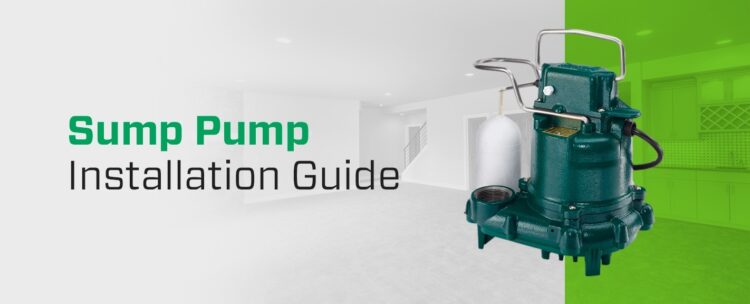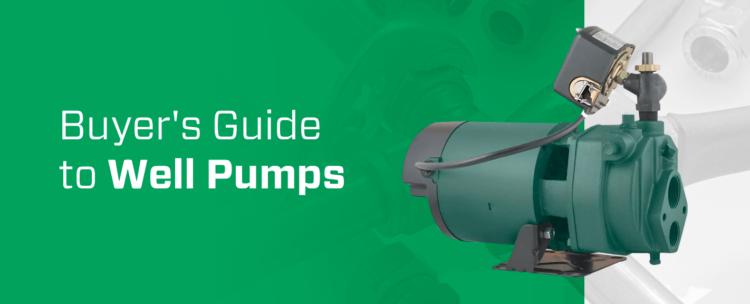Understanding what size sump pump to buy ensures the system can adequately pump water out of your basement and protect your home from water damage. Determining how much water your pump needs to move and how far it needs to pump the water is crucial to choosing the right system. This guide offers tips to help homeowners understand sump pump sizing for basements.
How Does a Sump Pump Work?
To determine the best sump pump size for your home, it’s helpful to first understand how a sump pump works. Sump pumps pull water from a home’s sump pit and push it outside through a discharge pipe to remove it from the home.
Pumps vary in size and capabilities, so different size pumps can handle different amounts of water. A pump’s capacity and total dynamic head allow it to apply the correct amount of motion and pressure needed to effectively pump accumulating water out of a home.
Purchasing a sump pump that’s too small could leave your basement vulnerable to water damage and mold, which can affect health. Purchasing a sump pump that’s too large could cause the pump to operate harder than it needs to, leading to wear and tear that reduces the pump’s life span.

What Size Sump Pump Do I Need?
Since choosing the right sump pump depends on size, knowing how to determine the proper size is essential. When you select a sump pump for your house, your main goal is to determine your home’s needs and then choose a pump that meets these needs.
Determine how much water you need to pump and where it needs to travel. You’ll then need to find a pump that can perform sufficiently without overperforming. The standard sump pump size for most homes is ⅓ HP, but it’s essential to check your home and make sure you choose a pump that can effectively move water out of your basement.
Before sizing a sump pump, it’s important to understand the following sump pump characteristics:
System Capacity
A sump pump’s system capacity refers to the amount of water it can move. Your pump must be able to pull water out of the sump pit faster than the basin collects incoming water, and the pump’s capacity determines its ability to do so.
You can determine capacity by measuring the amount of water the sump basin collects during a high-flow period. System capacity is also known as “flow,” and you can measure it at the following rates:
- Cubic feet per second (CFS)
- Liters per hour (LPH)
- Gallons per minute (GPM)
In the United States, most sump pump manufacturers measure system capacity or “flow rate” in gallons per minute, so a pump’s GPM reflects how many gallons of water it can move in a minute.
Total Dynamic Head
A pump’s total dynamic head measures how far a pump can move water. A sump pump system applies back pressure to the pump. The pump pushes water into a piping network, and the network pushes back on it as a response.
The pressure the system uses to push back is referred to as the total dynamic head, and it is measured in feet of water. While this may sound like it’s a measurement of length, it is actually a measurement of pressure. The total dynamic head is the sum of two components, which are static head and friction head. Adding a pump’s friction head to its static head reveals its total dynamic head.
Static Head
Static head is also known as vertical lift, and this measurement reflects the height that water needs to travel as the pump pushes it through the discharge pipe. Water flows into the bottom of a sump pump and exits a home’s basement through the discharge pipe, which extends upward vertically and then horizontally out of the house.
A pump’s static head is the vertical distance between the point where water enters the pump and the point where the discharge pipe bends horizontally. The longer a pump’s vertical head is, the harder it has to work to push water through the discharge pipe. This is because the pump has to push the water upward and work against gravity, so it requires more pressure to push the water long distances.
Friction Head
As a sump pump pushes water through a discharge pipe, water rubs against the pipe’s inner surfaces and creates friction. The pump must compensate for the friction because it slows down the water flow. Friction can increase due to the following factors:
- Narrow discharge pipes create more friction than wide discharge pipes.
- Pipe fittings such as check valves and elbows can increase friction.
- Friction increases with the length of a discharge pipe, so longer discharge pipes have more friction.

Sizing a Sump Pump
Each sump pump has a performance curve, which reflects its relationship between total dynamic head and capacity. You can determine the right size sump pump with the following steps:
1. Determine the Pipe’s Equivalent Length
A pipe’s discharge line diameter and pipe fittings determine the pipe’s equivalent length. Use the following pipe sizes and their fittings to calculate the equivalent length:
- 1 ¼ inch pipe: For a 1 ¼ inch pipe, each 90-degree elbow adds 3.5 feet to a pipe’s equivalent length. Each 45-degree elbow adds 1.8 feet, and each check valve adds 11.5 feet.
- 1 ½ inch pipe: If you have a 1 ½ inch pipe, each 90-degree elbow adds 4 feet to your pipe’s equivalent length. Each 45-degree elbow adds 2.2 feet, and each check valve adds 13.4 feet.
- 2-inch pipe: Each 90-degree elbow adds 5.2 feet to a 2-inch pipe, and each 45-degree elbow adds 2.8 feet. Each check valve adds 17.2 feet to 2-inch pipes.
- 2 ½ inch pipe: If your pump has a 2 ½ inch pipe, add 6.2 feet for each 90-degree elbow and 3.3 feet for each 45-degree pipe. For each check valve, add 20.6 feet.
- 3-inch pipe: If you have a 3-inch pipe, add 7.7 feet for each 90-degree elbow, 4.1 feet for each 45-degree elbow and 25.5 feet for each check valve.
Adding a pipe’s fittings together determines its equivalent length. For example, imagine you have a 1 ½ inch pipe with two 90-degree elbows and one check valve. The elbows add 8 feet of equivalent pipe, and the check valve adds 13.4 feet of equivalent pipe. This makes the pipe’s equivalent length 21.4 feet.
2. Determine the Pump’s Actual Pipe Length
A pump’s actual pipe length is a measurement of the pipe section that extends horizontally outside a home. This is the section that discharges water outside. Measure this section of the pipe to determine your pump’s actual pipe length.
3. Determine the Pipe’s Friction Loss Based on System Capacity
System capacity is how many water gallons per minute a pump can move, and friction loss measures how much friction slows water flow in the pipe. For every 100 feet of pipe, you can determine friction loss by the following gallons per minute or GPM:
- 4 GPM: If you have a ¾ inch pipe that moves 4 GPM, the system’s friction loss is 3.7. If you have a 1-inch pipe, the friction loss is 1.2. For a 1 ¼ inch pipe, the friction loss is .34.
- 6 GPM: A ¾ inch pipe that moves 6 GPM has a friction loss of 7.9, and a 1-inch pipe has a friction loss of 2.4. If you have a 1 ¼ inch pipe, the friction loss is .71, and it’s .33 for a 1 ½ inch pipe.
- 8 GPM: The friction loss for a ¾ inch pipe moving 4 GPM of water is 13.4. The friction loss is 4.1 for a 1-inch pipe, 1.19 for a 1 ¼ inch pipe or .56 for a 1 ½ inch pipe.
- 10 GPM: If a pump moves 10 GPM, the friction loss is 6.3 for a 1-inch pipe, 1.78 for a 1 ¼ inch pipe or .83 for a 1 ½ inch pipe.
- 12 GPM: A pump that moves 12 GPM has an 8.8 friction loss for a 1-inch pipe, 2.48 friction loss for a 1 ¼ inch pipe, 1.16 friction loss for a 1 ½ inch pipe or .34 friction loss for a 2-inch pipe.
- 14 GPM: If your pump moves 14 GPM, it has 11.7 friction loss for a 1-inch pipe, 3.29 friction loss for a 1 ¼ inch pipe, 1.54 friction loss for a 1 ½ inch pipe or .45 friction loss for a 2-inch pipe.
- 16 GPM: A pump that can move 16 GPM has 4.21 friction loss for a 1 ¼ inch pipe, 1.97 friction loss for a 1 ½ inch pipe or .58 friction loss for a 2-inch pipe.
- 18 GPM: If your pump can move 18 GPM, it has 5.25 friction loss for a 1 ¼ inch pipe, 2.41 friction loss for a 1 ½ inch pipe or .72 friction loss for a 2-inch pipe.
- 20 GPM: If your pump moves 20 GPM, the friction loss is 6.42 for a 1 ¼ inch pipe, 2.96 for a 1 ½ inch pipe or .88 for a 2-inch pipe.
- 25 GPM: A pump that moves 25 GPM has 10.39 friction loss for a 1 ¼ inch pipe, 4.8 friction loss for a 1 ½ inch pipe or 1.38 friction loss for a 2-inch pipe.
- 30 GPM: If a pump moves 30 GPM, the friction loss is 13.6 for a 1 ¼ inch pipe, 6.27 for a 1 ½ inch pipe or 1.81 for a 2-inch pipe.
- 35 GPM: A pump that moves 35 GPM has 19.2 friction loss for a 1 ¼ inch pipe, 8.82 friction loss for a 1 ½ inch pipe or 2.4 friction loss for a 2-inch pipe.
4. Calculate Friction Head
You can calculate your pump’s friction head by adding the discharge pipe’s equivalent length and actual length. Next, multiply the sum by the friction loss and then divide this number by 100.
Take our previous example and say there’s 100 feet of pipe. Add that to the pipe’s equivalent length 21.4 feet, getting 121.4. If the system operates at 6 GPM and the pipe is 1 ½ inches, we’d multiply 121.4 by .33 to get 40.062. Divide that by 100 to get .4, the friction head.
5. Calculate the Total Dynamic Head
To calculate a pump’s total dynamic head, add the friction head to the static head. Measure the vertical section of your pump’s discharge pipe to determine its static head, and then add this number to the friction head. For example, if the static head is 13 feet, and the friction head is .4, the total dynamic head is 13.4. Round this calculation up to 14 feet, and use this number to select your pump.
How to Choose a Pump
After determining the total dynamic head your pump needs, you can select a pump for your home. Sump pumps have curves or charts to reflect how many water gallons they can pump per minute for different dynamic head lengths. Since you’ve determined how many gallons per minute your pump needs to move, you can refer to sump pump charts to choose a pump that can handle the GPM you need it to.

How to Maintain a Sump Pump
Proper maintenance prolongs your sump pump’s life span and ensures it operates effectively. You can maintain your sump pump with the following tips:
Operate Your Pump When It Sits Dormant
Your pump automatically activates when water flows into the sump pit. However, if your basement goes several months without any water intake, the pump sits dormant because it’s not needed. If your pump sits inactive for several months, you should force it to operate by filling the sump basin with water. As the basin fills with water, make sure the pump operates properly.
Check the Float and Discharge Pipe
Check your float and discharge pipe to ensure they work properly. The pump’s float should be able to move up and down easily, and water should flow out of the discharge pipe when the pump operates. If water does not flow out of the discharge pipe, it could be due to one of the following reasons:
- Clogged water pipe
- Impeller issue
- Broken check valve
Quality Sump Pumps From Zoeller at Home
Zoeller at Home manufactures high-quality sump pumps to help homeowners protect their basements from water damage. We offer a variety of sizes, so you can choose one that best fits your home’s needs. Our factory-tested sump pumps are made with durable cast iron materials, allowing them to provide years of basement protection.
We offer durable sump pumps you can depend on. Whether you need a smaller sump pump such as the ⅓ HP Pro Cast Iron Sump Pump or a larger pump like the ¾ HP Dual Switch Submersible Sump Pump, you can find what you need at Zoeller.

Find the Right Size Sump Pump With Zoeller
Finding the right size sump pump is essential to keeping your basement dry and safe from water damage. The right size pump can effectively pull water from your basement and disperse it outside your home, helping you keep your home in excellent condition. With a few simple measurements and calculations, you can determine which size sump pump is right for your house. Browse a variety of sump pumps from Zoeller at Home to find a durable and reliable pump at a retailer near you.



